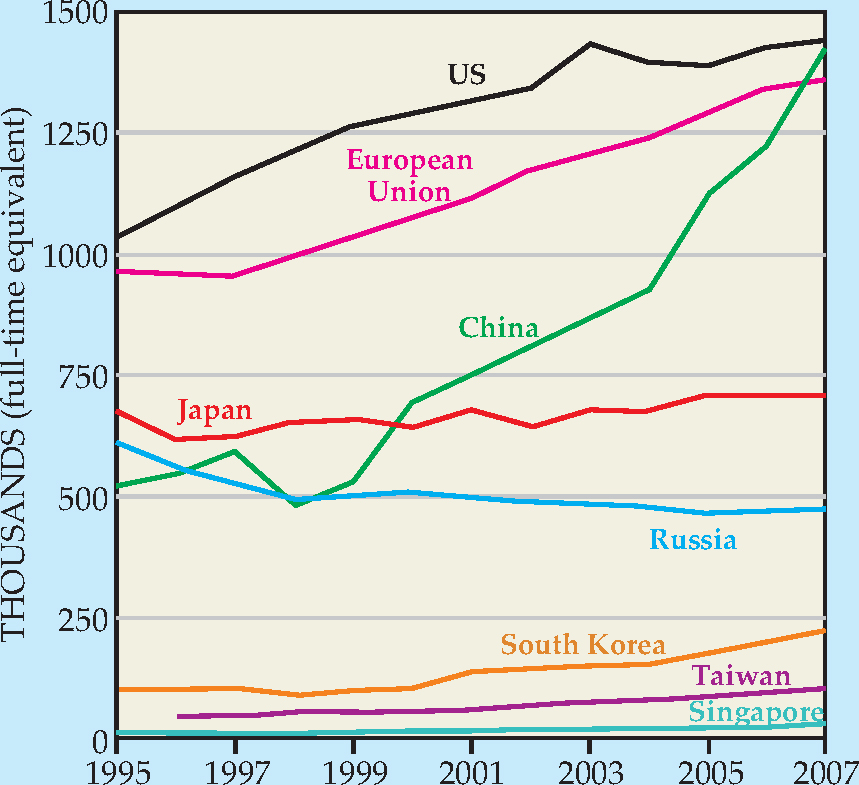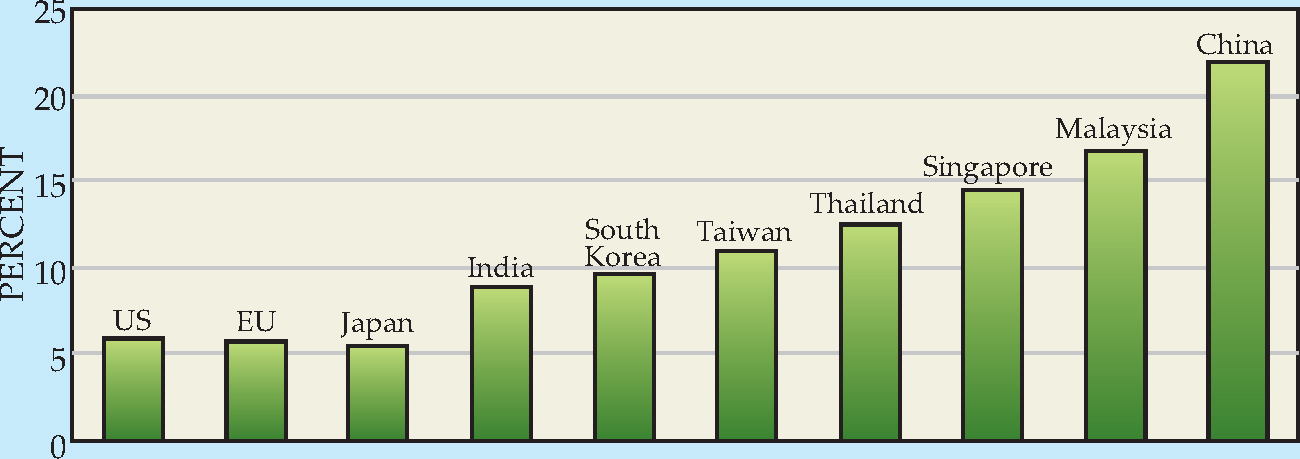Science Board details China’s leap in science and technology
DOI: 10.1063/1.3366235
If anyone still needs convincing on the speed with which China is ascending as a world science and technology (S&T) leader, the latest edition of Science and Engineering Indicators, the biennial encyclopedia of statistics assembled by the National Science Board (NSB), should suffice.
Whether measured by the numbers and growth rates of its science and engineering workforce, the volume of S&E graduate degrees awarded, the double-digit growth rates in expenditures on R&D, or the share of the world’s high-technology exports, China has made impressive gains over the past decade or so, as S&E Indicators attests. Take, for example, the number of S&E doctorates awarded annually in the nation, which rocketed from 1900 in 1993 to 23 000 in 2006, the most recent year for which data are available. (For a look at physics in China, see the article on
More stunning, perhaps, has been the surge in China’s research workforce, which has nearly tripled, from roughly 500 000 in 1995 to more than 1.4 million in 2007. In that year China was home to fully 25% of researchers worldwide, putting it on a par both with the US and with the European Union’s 27 member states, according to the report. Over the past two years, China has likely taken sole possession of first place by that metric. The country has already displaced the US as the world’s leading exporter of high-tech manufactured goods, grabbing one-fifth of the total in 2008. The US, which led the world in 1998 with 24% of those exports, saw its share plunge to 14% by 2008. In fact, the US trade balance in high-tech products turned negative after 1998 and has remained there ever since. In 2008 China exported more than $92 billion worth of high-tech products to the US, while US exports of such goods to China were just over $26 billion.
Attracting scientists
“China is achieving a dramatic amount of synergy not only by increasing investment in science and engineering education [and] increasing investments in research and development, but also [by] greatly increasing investments in infrastructure, which is attracting scientists from all over the world,” commented NSF director Arden Bement at a January press conference. The number of scientific collaborations between US and Chinese scientists is “dramatically increasing,” he noted. “From the vantage point of the collaborations we [NSF] support, China is far and away the country of choice” for US scientists to collaborate with. Indeed, NSF-supported US researchers are now more than twice as likely to collaborate with Chinese counterparts as they are with those in the next most likely nation, he said.
Bement’s observation reflects more recent data than appear in S&E Indicators and provides evidence that China’s S&T rise is ongoing. In the report, China is ranked fourth, behind the UK, Canada, and Germany, among nations whose researchers had coauthored S&E articles with US scientists and engineers in 2008. But an NSF spokeswoman said that Bement referred to only international collaborations supported by NSF funds, which involve a limited set of China’s researchers. Rolf Lehming, NSF’s S&E Indicators program director, said it is plausible that extrapolating historical trends would show that Chinese researchers are now involved in nearly 20% of all NSF-funded international research collaborations.
The report shows that China’s investment in R&D has been sustained over the past decade or longer. Spending on R&D has grown at a blistering 22% average annual rate from 1996 to 2007. The US, by comparison, mustered 5.8% average growth during that period. Although big percentage jumps are often discounted as having begun from a low base, Bement noted that if that were so, the steep slope of China’s growth curve should be declining, which isn’t the case. Indeed, he said, “many of the indicators show an acceleration rather than a deceleration.”
A steep slope
Measured by the number of peer-reviewed S&E research articles in 2007, China has become the second most prolific contributor, behind the US. That is up from 14th place just 10 years earlier. Measured by the number of articles appearing in high-impact journals, however, China still lags well behind the US and European Union in terms of quality, noted NSB member Jose-Marie Griffiths. And China’s S&T growth has yet to change what has been a near-absence of Chinese researchers who are awarded patents in the US and Europe.
The NSB, the governing board of NSF, has been charged since its inception in 1950 with the role of advising the president on broad science policy issues, though in practice it has rarely done so. This year, however, the board will issue a companion report offering policy recommendations to the White House on the topic of globalization in science and engineering. Louis Lanzerotti, who chairs the NSB committee in charge of S&E Indicators, said the policy report, scheduled for release after Physics Today went to press, will address the challenges and opportunities that are presented by increased globalization, including greater opportunities for international S&T collaboration.

Researchers in selected regions: 1995-2007
Source: National Science Board,


Average annual growth of R&D expenditures for US, European Union, and selected Asian economies: 1996-2007
Source: National Science Board,

More about the Authors
David Kramer. dkramer@aip.org




